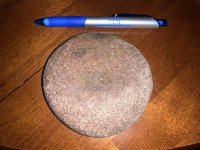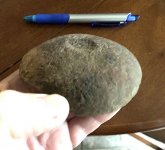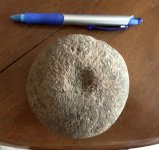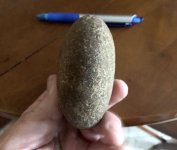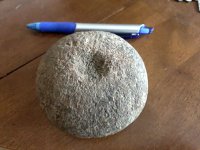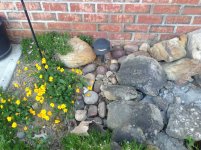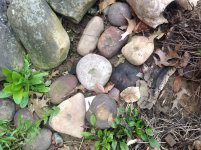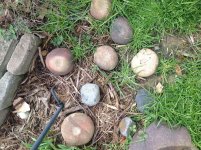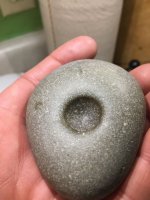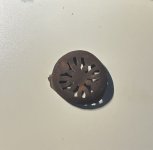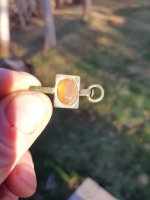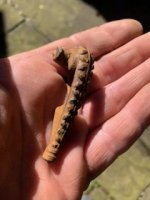You are using an out of date browser. It may not display this or other websites correctly.
You should upgrade or use an alternative browser.
You should upgrade or use an alternative browser.
Round stone with perfectly symmetrical edges
- Thread starter pingdis
- Start date
Buckleberry
Hero Member
- Sep 4, 2010
- 636
- 786
Nutter, maybe discoidal. Nice, certainly worked.
- Jul 27, 2006
- 48,419
- 54,768
- Detector(s) used
- Minelab_Equinox_ 800 Minelab_CTX-3030 Minelab_Excal_1000 Minelab_Sovereign_GT Minelab_Safari Minelab_ETrac Whites_Beach_Hunter_ID Fisher_1235_X
- Primary Interest:
- All Treasure Hunting
Spent many hours and walk for miles looking for tool in area, then find one in my backyard.
Never know where you will find one. I found my first point when I was relieving myself in a farmers field, let's just say I found the point when dirt was washed off..
Al D
Bronze Member
Looks like an old fishing weight, but the maker never finished it.
Gold Maven
Bronze Member
- Jul 4, 2012
- 2,286
- 2,101
- Detector(s) used
- Tesoro Lobo
- Primary Interest:
- All Treasure Hunting
hammer stone is what i would call it, to crack bones for the marrow.
Tesorodeoro
Bronze Member
- Jan 21, 2018
- 1,233
- 1,925
- Primary Interest:
- All Treasure Hunting
That’s a good one.
Garscale
Bronze Member
It's a very nice artifact. Multi purpose. The holes are for holding a spinning shaft of a bow drill when starting a fire or drilling wood. Stone is shaped to the hand and may have been used to abraid or dress skins. Nice one.
The Grim Reaper
Gold Member
It's a very nice artifact. Multi purpose. The holes are for holding a spinning shaft of a bow drill when starting a fire or drilling wood. Stone is shaped to the hand and may have been used to abraid or dress skins. Nice one.
I have to respectfully disagree. I have heard for years that these were used as Bow Drill Toppers but I have yet to see one that shows the polish inside the hole that would occur from wooden shafts rotating back and forth inside said hole. I never adhered to the "nutting stone" theory either. Why do you need a round stone with hole on both sides to break open a nut? Just put it on a flat surface and hit it with another stone. Viola, a broken open nut. I call them Pitted Stones and I believe most are either Hammerstones or Anvil Stones.
I have a lot of these Pitted Stones and none show polish in the divots.
Attachments
CHUDs
Sr. Member
The Grim Reaper
Gold Member
It's possible CHUDS, but to be honest it's more likely just an Omarulluk and completely natural.
CHUDs
Sr. Member
My understanding is that Omarulluks are Midwestern. This was found at a known site in the coastal CA mountains which are comprised of sandstone and decomposed granite. I suppose it’s possible that it is natural but context would lead me to believe otherwise.
southfork
Bronze Member
My understanding is that Omarulluks are Midwestern. This was found at a known site in the coastal CA mountains which are comprised of sandstone and decomposed granite. I suppose it’s possible that it is natural but context would lead me to believe otherwise.
Looks like polish to me ? fire starter / bow drill cap makes you wonder when found out in the hills .
pingdis
Full Member
- Thread starter
- #15
I have to respectfully disagree. I have heard for years that these were used as Bow Drill Toppers but I have yet to see one that shows the polish inside the hole that would occur from wooden shafts rotating back and forth inside said hole. I never adhered to the "nutting stone" theory either. Why do you need a round stone with hole on both sides to break open a nut? Just put it on a flat surface and hit it with another stone. Viola, a broken open nut. I call them Pitted Stones and I believe most are either Hammerstones or Anvil Stones.
I have a lot of these Pitted Stones and none show polish in the divots.
Thomas M.N. Lewis and Madeline D. Kneberg Lewis in their exhaustive 2 vol. set "The Prehistory of the Chickamauga Basin in Tennessee", which includes the region of the lower Hiwassee River where this was found, calls this a "Pitted Pebble" and is almost always quartzite, and by far the most common form of hammerstone.
Top Member Reactions
-
 2605
2605 -
 1157
1157 -
 1046
1046 -
 892
892 -
 872
872 -
 843
843 -
 787
787 -
 675
675 -
 661
661 -
 641
641 -
 492
492 -
 470
470 -
 467
467 -
 462
462 -
 459
459 -
 432
432 -
 415
415 -
 409
409 -
O
401
-
 389
389
Users who are viewing this thread
Total: 2 (members: 0, guests: 2)
